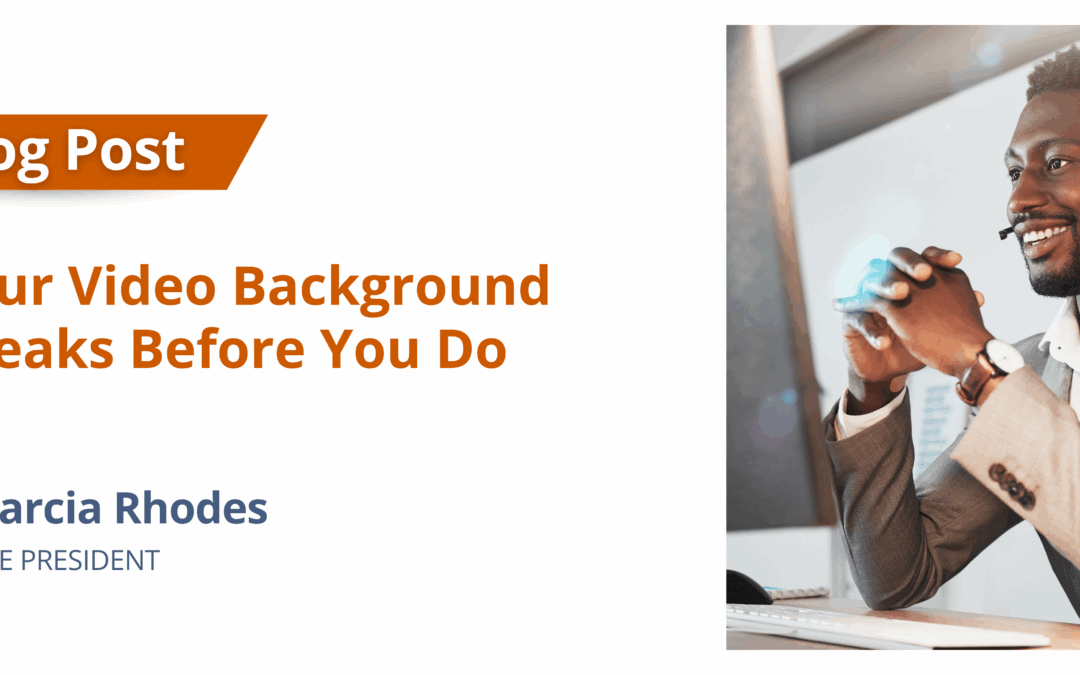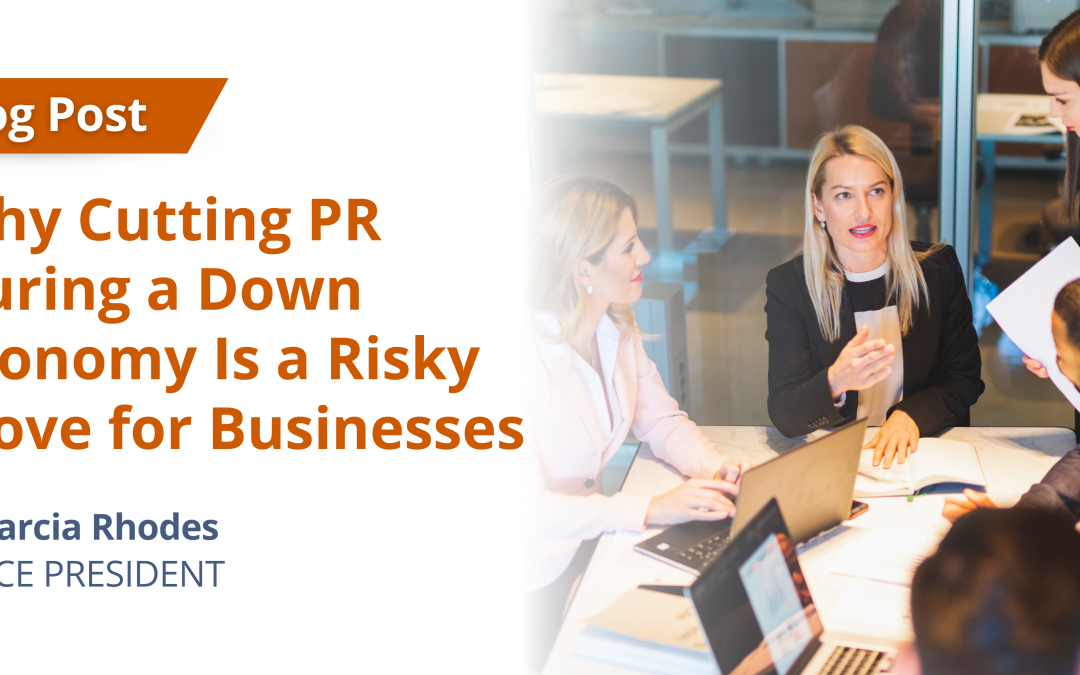
by Marcia Rhodes | Sep 17, 2025 | Blog
When it comes to video interviews, webinars, or executive briefings, it’s often the small details that leave the biggest impression. Reporters, clients, and colleagues notice more than you might think. Your appearance isn’t just about how you look — it’s also about what’s behind you.
Your video background communicates professionalism, attention to detail, and self-awareness. Done well, it can even create connection. Done poorly, it can undermine your credibility before you’ve spoken a word.
The following are a few pro tips to make sure your video background says the right things:
- Tidy Up Your Space
If you’re taking a call from a hotel room or temporary set-up, small details matter:
- Close the bathroom door
- Make the bed
- Remove visible clutter or personal items
Reporters and executives notice details more than you might expect. One client, for instance, left a stack of messy file folders teetering on the edge of his desk during a media interview. Instead of focusing on his insights, the journalist joked about him “needing to go paperless.” It became a distraction — and definitely not the impression he wanted to leave.
On the flip side, another client had framed artwork from his young kids behind him. Instead of being a distraction, it turned into a warm conversation starter with the reporter — humanizing him and creating rapport before the interview even began.
- Lighting is Key
Good lighting helps you appear clear and engaged. Poor lighting makes you look tired, shadowy, or unprofessional. Natural light works best, but if that’s not possible, invest in a ring light.
Ring lights are affordable and can even double as a desk light. Choose one with adjustable brightness and color temperature (so you can switch from warm to cool light). If you wear glasses, look for one with diffused lighting or try angling it to avoid glare.
- Virtual Background or Not?
Virtual backgrounds can be tempting, especially if you’re in a pinch. But they often glitch or create an unnatural “halo effect” around your head. Unless you’re using a branded or professional image that your computer handles flawlessly, PR pros generally advise against them.
Authenticity resonates. A neutral wall, bookshelf, or well-lit corner beats a digital beach scene every time. One client displayed an acrylic frame holding a small beanie cap. When the reporter asked about it, she explained it was what her daughter was wearing the day she passed away. The reporter was deeply moved — and the interview shifted from transactional to personal, shaping a much more meaningful piece.
- Do a Tech + Visual Check
Before the call:
- Open your video and review what your setup looks like
- Move distracting items out of the frame
- Make sure nothing odd is visible (an open closet, dishes, laundry, or even a pet sneaking in)
Think of it as a dress rehearsal for your space. If time allows, have your PR manager do a quick one-minute visual check before every call, ensuring not just your appearance but also that your background is ready. I once did a visual check with a client and saw that he had a poster in a foreign language behind him. I asked him what the slogan said and since he had no idea, we agreed to take it down to be safe.
Final Thought
Your video background doesn’t just fill the screen — it fills in the story about you. When it’s intentional, it can signal professionalism, warmth, or even humanity in ways that words alone can’t. Treat it as part of your communication strategy, not an afterthought.

by Marcia Rhodes | Feb 19, 2025 | Blog
A strong partnership with a public relations (PR) agency offers numerous benefits to companies by generating attention and interest that draws in new employees, industry partners, and, most importantly, customers.
More and more companies are realizing the value of PR, as globally the PR market is expected to grow to more than $133 billion by 2027. In the U.S., demand for PR specialists is predicted to grow by about 6% by 2032 (faster than average), according to BLS.gov.
However, achieving stellar PR results requires some upfront efforts to ensure the alignment of goals and objectives between the client and the PR agency. The best PR agency–client relationships are characterized by collaboration, respect, unity, and a mutual understanding of the end goals and expectations.
Following are some tips for successful PR partnerships:
Establish a single source of contact: Designate a dedicated liaison who is accessible and responsive to requests for data and media interviews. The ideal partner shares information on company activities and news proactively and views the PR agency as a partner, not a vendor.
Know your people: Draw up a list of spokespeople, including internal executives and customers who will sing your praises, who can participate in media opportunities, as well as the specific topics they prefer to focus on. When it comes to healthcare media relations, it’s always best to lead with a provider customer than a solution provider.
Create the culture: The brands that realize the most value from PR have established a company culture that encourages adoption of new concepts and strategies. An essential component of this is a leadership team that sees the value of PR and its important role in the marketing mix to drive credibility, recognition, and brand awareness, as well as fueling ongoing online content marketing across integrated PESO (Paid, Earned, Shared and Owned) channels.
Develop a social plan: Social platforms such as LinkedIn offer another avenue beyond traditional media for brands to establish thought leadership and contribute to relevant industry conversations. To get the most out of social media, develop a written social media strategy and guidelines (we can help!) about having an active presence on relevant platforms. It is also a big help to have an executive team and employees who are — or willing to become — social media apostles.
See the big picture: Generating the media interest that will lead to valuable coverage and market attention doesn’t happen overnight. It’s important for clients to have a company-wide understanding that PR is not a “project,” but rather a process that should be integrated into every function of the organization from marketing and sales to product development and human resources.
Other factors that set the stage for a productive PR partnership include having a clear brand voice and message strategy, an optimized website, and a customer relationship management tool with a solid process in place for managing leads. (If you don’t have any of these, we can help get you there!) Ultimately, like all relationships, the PR agency–client partnership is all about taking the time to clearly communicate and understand each other to establish productive and positive collaborations.

by Marcia Rhodes | Nov 27, 2024 | Blog
If a cruise ship is taking on water, you can bet that the passengers hope the cruise line has adequately invested in lifeboats.
Public relations (PR) in a down economy is no different. Companies that continue to devote resources to PR during downturns can emerge with stronger brand positioning once the economy rebounds, while those that go dark may struggle to regain traction.
PR investment is important during a down economy for several reasons:
- Reputation management: During an economic downturn, businesses face numerous challenges such as layoffs, financial difficulties, and reduced consumer spending. PR helps manage a company’s reputation by maintaining open lines of communication with stakeholders, including customers, employees, investors, and the media. Positive PR can help minimize damage to a company’s image and build trust and credibility, which is crucial during tough economic times.
- Building trust and confidence: When the economy is struggling, consumers become more cautious with their spending. They seek assurance and want to invest in companies they trust. Effective PR campaigns can help build trust by highlighting a company’s positive attributes, showcasing its resilience, and demonstrating its commitment to customer satisfaction. By maintaining transparent and open communication, PR can foster confidence and encourage consumers to continue supporting the brand.
- Differentiation and competitive advantage: A down economy often leads to increased competition, as businesses strive to survive and capture a smaller pool of B2B spending and investment capital. PR can help differentiate a company from its competitors by highlighting its unique value proposition, highlighting its strengths, and showcasing success stories. Effective PR can position a company as a thought leader, innovator, or industry expert, giving it a competitive edge and attracting clients who are seeking stability and reliability.
- Employee morale and retention: Economic downturns often result in layoffs, pay cuts, or reduced work hours, which can negatively impact employee morale and loyalty. PR plays a crucial role in internal communications, keeping employees informed about the company’s situation, addressing concerns, and showcasing positive initiatives. By highlighting success stories, recognizing employee achievements, and emphasizing the company’s commitment to its workforce, PR can boost morale, enhance loyalty, and improve employee retention during challenging times.
- Stakeholder engagement: In a down economy, businesses face increased scrutiny from various stakeholders, including investors, regulators, and the media. Effective PR helps engage these stakeholders through proactive communication, addressing concerns, and providing transparent updates on the company’s financial health, strategies, and initiatives. By maintaining strong relationships with stakeholders, businesses can mitigate potential negative consequences and foster support, which is crucial for survival and recovery.
Overall, PR during a down economy is essential for maintaining and enhancing a company’s reputation, building trust and confidence, differentiating from competitors, boosting employee morale, and engaging key stakeholders. These factors contribute to the long-term success and resilience of a business, even in challenging economic conditions.

by Marcia Rhodes | Mar 7, 2023 | Blog
Many PR and marketing professionals hold the mistaken belief that analyst briefings are pointless unless their company has a paid subscription with the analyst firm. Analyst relations are frequently one of the first items marketers seek to remove from our PR proposals.
We firmly believe it is worthwhile for your organization to conduct an “earned” briefing, similar to the earned opportunities your PR team is actively seeking from the media. This is true even if your organization does not have a paid relationship with an analyst firm. Analysts are typically flexible when it comes to scheduling calls or even in-person briefings, provided the privilege of an earned briefing is not misused. Nonetheless, make sure you have something significant to say, and that you are ready for challenging inquiries regarding the strategy, target markets, clients, and even the financials of your firm.
Executives looking to make significant buying decisions about healthcare technology solutions often rely on analyst recommendations. Several companies rely on the rankings of a well-known analyst firm and send their RFPs only to the top 5 vendors on those lists. It is critically important that your organization is included among vendor recommendations when your prospects check in with analysts.
Yes, you’ll probably have to take a sales call along with the briefing. But the intrinsic, long-lasting value of getting in front of key analysts who decide to make the lineup for recommendations makes that 30 extra minutes listening to a sales spiel about their services and events well-worth the effort. Plus, the media often turns to analysts for expert insights. While analysts usually don’t reference specific vendors in their quotes, you do want them to be aware of your positioning so that when they are quoted in the media, your organization’s vision is helping to shape the thinking behind their comments.
Which are the key analyst firms you should consider targeting for “earned” briefings? In general, the most well-known firms are Gartner, Advisory Board, IDC, Forrester, Frost & Sullivan, KLAS, Chilmark, S&P Global and Signify Research. There are analysts, such as Mike Feibus of FeibusTech, who also write articles for media outlets.
Regular briefings with the pertinent analysts at these firms should be a part of your analyst relations strategy. Several of them regularly attend health tech conferences such as HIMSS, ViVE and HLTH. Your PR team should be making sure you connect with them in person during the show. The meet-and-greet at these shows should lead to a full briefing via Zoom a few weeks after the show.
If there is no opportunity to meet in person, visit the analyst firm’s website to view a list of the reports they intend to release throughout the course of the year. Create a briefing schedule based on these reports and then complete an online form requesting a briefing with the pertinent analyst.
So, you got the briefing booked. Now what? Be sure to read “Analyst Briefings Best Practices” for recommendations to help you prepare, including who should attend the meeting, what slide content to include and how many slides you need, practicing your presentation, and more.

by Marcia Rhodes | Feb 1, 2023 | Blog
Many of our clients who accept an invitation to appear as a guest on a podcast are shocked when they learn that the interview included a video recording that was uploaded to YouTube. Keep in mind that even if the interview is in podcast form, you should always be ready for a possible video interview. No problem as you frequently use Zoom for calls. Right?
Zoom is undoubtedly the most user-friendly video platform in the world. It enables remote interviews without requiring a complex home studio setup. But there’s a catch: you’re now in charge of your own lighting, audio, and makeup.
Do not fret. There is no need to put in hours attempting to simulate an interview created by a professional company. Get the following fundamentals down, and you’ll exude assurance, polish and warmth.
#1: Learn about the “Touch up my appearance” tool in Zoom. Your video display receives an instant soft focus, giving it a more polished image.
#2: Steer clear of virtual backgrounds. They’re enjoyable with friends and coworkers, but not suitable for interviews with the press. The ideal setting is a neat home office. However, if you don’t have a specific working area, pay attention to your surroundings. A messy bed, an open bathroom door, or a background mirror might be embarrassing. Additionally, look for a location where you can keep out kids, other people, and your pets to prevent this scenario.
#3: Do not position yourself too near the camera. This gives the potential viewer the unsettling impression that a huge face is staring back at them through their computer screen. Put yourself in a position where your head, shoulders and chest are visible to the camera.
#4: Dress in professional business attire. On video, solid blue clothing projects well; however white could make you appear washed out. Avoid wearing jewelry with loud or dangling charms or busy patterns that will draw attention away from what you are trying to express.
#5: Powder your nose and forehead to “de-shine.” Any shine gets exaggerated on video and can be distracting. If you don’t happen to have a compact of powder on hand, crank up your AC ahead of the interview.
#6: Keep looking the audience in the eye. Direct your attention to the camera on the laptop or computer screen. To make sure that your eyes are pulled to the camera, experts advise adding an arrow.
#7: It’s a good idea to write down three important points that you want to remember and set them nearby, out of sight of the camera. It is preferable to glance down at notes rather than up at the ceiling when trying to remember anything. In fact, looking up during an interview makes candidates seem dishonest. To use as “cue cards,” you may also put up your talking points against the side of your camera.
#8: Instead of using your smartphone, use a laptop or desktop PC. Your interviewer will be able to capture you in landscape mode this way.
#9: Always rehearse with a coworker to ensure that all of the above have been taken into account. Your confidence and memory of the information you wish to convey will both be greatly improved by even one practice session.
If you would like coaching on what to say and how to say it during interviews, consider taking some “Media Training.” Everyone gains significantly from it, regardless of how frequently they have been the subject of media interviews. To learn more about our media training programs, contact Amendola at info@acmarketingpr.com.
Best of luck with your next video interview!




